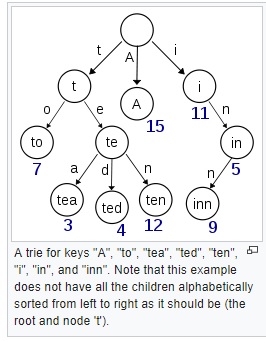Trie is a useful data structure allow us to search a given word or check if any words start with prefix in O(N) efficient time. The following is the C++ implementation of Trie Class which is based on unordered_map hash map instead of a fix-size e.g. 26 children. The advantages of doing so is that we can use the Trie class in basically any character set (not just English lowercase/uppercase).
1 2 3 4 5 6 7 8 9 10 11 12 13 14 15 16 17 18 19 20 21 22 23 24 25 26 27 28 29 30 31 32 33 34 35 36 37 38 39 40 41 42 | class Trie { public: Trie() { leaf = false; } unordered_map<char, Trie*> children; bool leaf; void add(string s) { auto root = this; for (const auto &n: s) { if (!root->children[n]) { root->children[n] = new Trie(); } root = root->children[n]; } root->leaf = true; } bool exists(string word) { auto root = this; for (const auto &n: word) { if (!root->children[n]) { return false; } root = root->children[n]; } return root && root->leaf; } bool startswith(string p) { auto root = this; for (const auto &n: p) { if (!root->children[n]) { return false; } root = root->children[n]; } return root != NULL; } }; |
class Trie {
public:
Trie() {
leaf = false;
}
unordered_map<char, Trie*> children;
bool leaf;
void add(string s) {
auto root = this;
for (const auto &n: s) {
if (!root->children[n]) {
root->children[n] = new Trie();
}
root = root->children[n];
}
root->leaf = true;
}
bool exists(string word) {
auto root = this;
for (const auto &n: word) {
if (!root->children[n]) {
return false;
}
root = root->children[n];
}
return root && root->leaf;
}
bool startswith(string p) {
auto root = this;
for (const auto &n: p) {
if (!root->children[n]) {
return false;
}
root = root->children[n];
}
return root != NULL;
}
};The space complexity for Trie class is often O(MN) where M is the number of strings to add and the N is the average length of the words. The time complexity of Trie is O(N) where N is the length of the given string to lookup, add or check if any starts with it (prefix check).
We can use the Trie in the following way:
1 2 3 4 | Trie trie; trie.add("hello"); trie.startswith("hel"); // true trie.exists("hel"); // false |
Trie trie;
trie.add("hello");
trie.startswith("hel"); // true
trie.exists("hel"); // falseTrie Algorithms Implementations:
- Teaching Kids Programming – Python Implementation of Trie Data Structure (Prefix Tree)
- C++ Implementation of Trie Data Structure using Hash Map
- The Beginners’ Guide to Trie: How to Use the Trie in C++?
- Trie Class Data Structure in Python
- GoLang: Implement Trie (Prefix Tree)
–EOF (The Ultimate Computing & Technology Blog) —
loading...
Last Post: Recursive Algorithm to Compute the Linked List Jumps
Next Post: Depth First Search Algorithm (Preorder Traversal) to Compute the Kth Smallest in a Binary Search Tree
